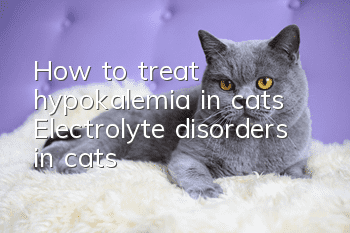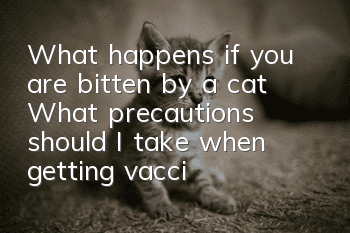How to treat hypokalemia in cats? Electrolyte disorders in cats

Hypokalemia is also an electrolyte disorder in cats. Potassium ions are the material basis for maintaining the resting potential of cell membranes, and regulate the osmotic pressure and acid-base balance of intracellular and intracellular fluids. It participates in various metabolic processes and interacts with glycogen. Closely related to protein synthesis. Cats rarely experience a decrease in potassium ion concentration when they eat a normal diet, but when they experience vomiting, diarrhea, or increased urine output, they can quickly develop hypokalemia.
1. Cause
Loss of appetite, vomiting, diarrhea, etc. can cause hypokalemia, which can be divided into the following aspects according to different mechanisms: ① Reduced potassium ion intake, transfer of extracellular potassium into cells, urine or gastrointestinal tract Increased secretion of potassium ions; ② iatrogenic hypokalemia, such as long-term infusion of liquids that do not contain potassium ions; ③ pseudohypokalemia, depending on the detection method of serum potassium concentration; ④ hyperlipidemia, hyperlipidemia, Pseudohypokalemia caused by proteinemia (higher than 10g/dl), hyperglycemia (higher than 750mg/dl) and azotemia (urea nitrogen concentration higher than 115mg/dl).
2. Clinical characteristics
When a cat suffers from hypokalemia, it will affect the functions of its cardiovascular, central nervous system, digestive tract, urinary tract and muscles
1.1 Neuromuscular system
When the serum potassium ion is <3.0mmol/L, weakness in the muscles of the limbs may occur, and if the serum potassium ion is <2.5mmol/L, paralysis may occur. The muscles of the limbs are the most prominent, and tendon reflexes are slow or disappear. No matter how severe it is, breathing difficulties or even coma may occur.
1.2 Digestive system
Potassium deficiency can cause weakened intestinal motility, and cats may suffer from loss of appetite, vomiting, abdominal distension, and paralytic intestinal obstruction
1.3 Cardiovascular system
Hypokalemia will increase myocardial excitability, cause arrhythmia, ventricular tachycardia, drop in blood pressure, enlarge the heart, and finally the heart will stop beating in a systolic state
1.4 Urinary system
Long-term hypokalemia can cause potassium deficiency nephropathy and renal dysfunction, and the renal concentrating function decreases. Polyuria occurs with low urine specific gravity. It can also cause loss of bladder smooth muscle tone and urinary retention.
1.5 Disorders of the body’s acid-base balance lead to metabolic alkalosis
3. Diagnosis
Testing of serum potassium concentration can determine whether hypokalemia is present. The underlying cause can often be found based on medical history, physical examination, routine blood tests, serum biochemical tests and urinalysis. If the cause cannot be determined from this information, less common factors such as renal tubular acidosis or other renal potassium-wasting disorders, primary aldosteronism, and hypomagnesemia should be considered. To differentiate between renal and nonrenal potassium loss,Fractional potassium ion excretion must be measured, which can be calculated by measuring potassium and creatinine concentrations in urine and serum or by measuring 24-hour urinary potassium excretion. We can also make a diagnosis based on electrocardiogram examination. If the cat's serum potassium concentration is lower than 3.5mmol/L, it can be diagnosed as hypokalemia.
4. Treatment
The main treatment method for hypokalemia is to supplement potassium salts. Potassium supplementation should be administered orally as much as possible, and potassium supplementation sustained-release agents can be used. Side effects include poor palatability (can be taken with food to lessen this effect) and gastrointestinal irritation, including vomiting, diarrhea, and melena. The recommended dose is 2.2 mEq of potassium per 100 kcal of daily energy requirement, or 2 mEq of potassium per kilogram of body weight, twice a day. Subsequent adjustments should be made based on clinical response and serum potassium concentration testing. If oral supplementation is not possible (e.g., vomiting, loss of appetite), it may be given parenterally. Potassium chloride is commonly used in clinical practice and has the effect of supplementing potassium and chlorine at the same time. In addition to potassium chloride, potassium phosphate is also commonly used when cats suffer from diabetic ketoacidosis to prevent hypophosphatemia. Although potassium chloride can be supplemented subcutaneously (as long as the potassium concentration does not exceed 30 mEq/L), intravenous infusion is preferred.
During the period of intravenous potassium supplementation, the serum potassium concentration should be measured every 6 to 8 hours, and then the potassium supplement should be adjusted accordingly. The purpose is to restore the normal potassium concentration and stabilize the potassium concentration in the normal range after stopping treatment. Clinical symptoms of hypokalemia usually disappear 1 to 5 days after the potassium ion concentration is corrected. Depending on the underlying cause, long-term oral potassium supplementation may sometimes be needed to avoid recurrence of hypokalemia.
- Can cats eat shredded squid? Will it cause gastrointestinal diseases?
- What should you do if cats often fight?
- In which months is cat shedding season?
- What can pregnant cats use to get rid of fleas?
- Why should cats bury their poop?
- Symptoms and treatment of cat eczema
- What are the symptoms of Garfield's hiccups?
- Why does the cat keep purring?
- Why is there blood in the kitten's vomit?
- How to deworm cats externally (Illustration of the correct method for external deworming of cats)



